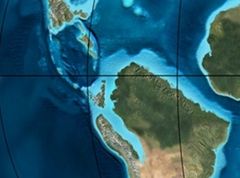| Hondita Formation | |
|---|---|
| Stratigraphic range: Turonian ~ | |
| Type | Geological formation |
| Unit of | Güagüaquí Group |
| Underlies | Loma Gorda Formation |
| Overlies | not observed |
| Thickness | up to 90 m (300 ft) |
| Lithology | |
| Primary | Sandy limestone, shale |
| Other | Calcareous concretions |
| Location | |
| Coordinates | 4°30′47″N 74°52′32″W / 4.51306°N 74.87556°W |
| Approximate paleocoordinates | 3°00′S 52°00′W / 3.0°S 52.0°W |
| Region | Upper Magdalena Valley, Central & Eastern Ranges, Andes |
| Country | |
| Type section | |
| Named for | Quebrada Hondita |
| Named by | De Porta |
| Location | Piedras, Tolima |
| Year defined | 1966 |
| Coordinates | 4°30′47″N 74°52′32″W / 4.51306°N 74.87556°W |
| Region | Cundinamarca, Huila, Tolima |
| Country | |
 Paleogeography of Northern South America 90 Ma, by Ron Blakey | |
The Hondita Formation (Spanish: Formación Hondita, Ksh) is a fossiliferous geological formation of the Upper Magdalena Valley (VSM) and surrounding Central and Eastern Ranges of the Colombian Andes, extending from Cundinamarca in the north to Huila and easternmost Tolima in the south. The lowermost unit of the Güagüaquí Group, a sequence of sandy limestones and shales, dates to the Late Cretaceous period; Turonian epoch, and has a maximum thickness of 90 metres (300 ft).
Fossils of Yaguarasaurus columbianus, said to be found in the time-equivalent La Frontera Formation (listed as "La Frontera Member"), were actually recovered from the Hondita Formation as the stratigraphic unit present in the Quebradas El Ocal and Itaibe, Huila.